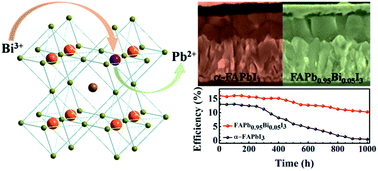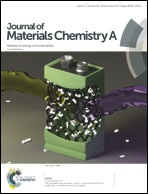Enhancing moisture-tolerance and photovoltaic performances of FAPbI3 by bismuth incorporation†
Abstract
The power conversion efficiency (PCE) of perovskite-based solar cells has already exceeded of 22% due to their unique optoelectronic properties. However, the long-term ambient air stability as the Achilles' heel of such promising photovoltaic materials has to be solved for commercialization. Herein, a facile method that partially substitutes B-site Pb2+ by Bi3+ was suggested to enhance moisture tolerance and photovoltaic performances for FAPbI3. The partial incorporation of Bi in FAPbI3 tuned a more favourable tolerance factor and suppressed the phase transition from black perovskite phase to yellow non-perovskite phase at room temperature. The solar cells based on the incorporation of 5 mol% Bi3+ compounds achieved a substantially improved PCE of 17.78%, which is much higher than that of the controlled device with pure FAPbI3 (13.02%). Moreover, the optimal solar cell showed remarkable stability, maintaining 62.38% of the initial PCE without encapsulation for 1000 h under ambient conditions at 25 °C with relative humidity of 30%. This work further demonstrated the possibility of substituting Pb2+ by non-equivalent elements, thus opening the door for further developments of such promising materials.



 Please wait while we load your content...
Please wait while we load your content...